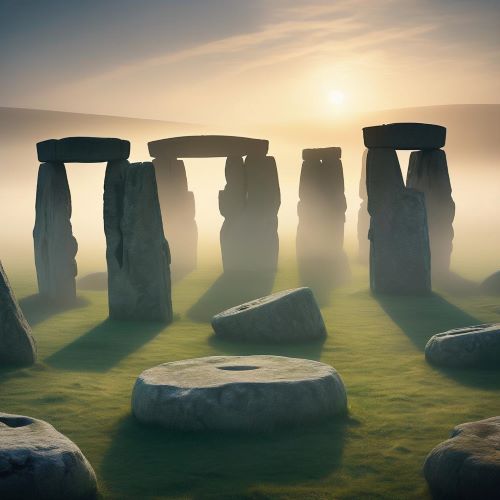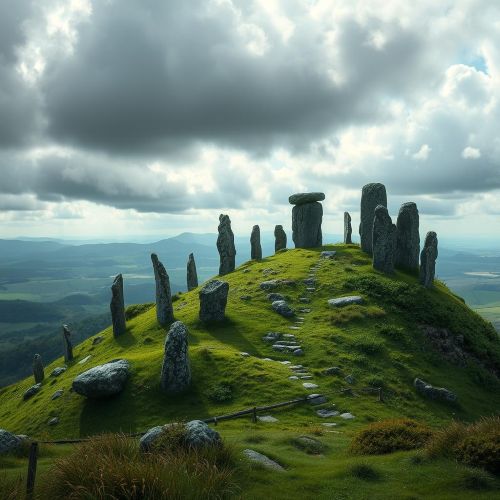Jelling Stones : The Birth Certificate
At a glance
| Description | |
|---|---|
| Mythology | Nordic Mythology |
| Country | Denmark |
| Closest airport | Billund Airport (BLL) |
| Type | Constructed |
| Accessibility | 10/10 |
Introduction
The Jelling Stones in Denmark are monumental runestones from the 10th century, integral to the UNESCO-listed Jelling complex alongside the mounds and church. Erected during the reigns of King Gorm and his son Harald Bluetooth, they commemorate Denmark’s unification and the region’s shift to Christianity. Often called “Denmark’s birth certificate,” these inscriptions in ancient Nordic script highlight the Viking legacy and continue to draw historians, archaeologists, and travelers fascinated by the nation’s past.
Connection with Mythology
The Jelling Stones serve as a bridge between Viking heritage and the Christianization of Denmark. Raised by King Gorm the Old and his son, Harald Bluetooth, they blend Nordic symbolism with Christian iconography. The larger stone, commissioned by Harald, prominently displays an early depiction of Jesus Christ, yet its artistic influences remain deeply rooted in Norse traditions. These carvings reflect the cultural and religious crossroads of the era, capturing a society in transition.
Thyra, Gorm’s wife, holds a special place in Danish history, and her association with the stones has led some scholars to compare her status to that of Nordic goddesses. The inscriptions honor her legacy while also portraying Harald as both a unifier and a promoter of Christianity. This fusion of belief systems underscores the adaptability of Viking culture as it integrated new religious influences without entirely discarding its ancestral roots.
Harald’s acceptance of Christianity in the 960s AD marked a turning point for Denmark. To solidify this shift, he commissioned the construction of a wooden church near the Jelling site and even reburied his parents in Christian tradition. The inscriptions on the larger stone not only proclaim his role in uniting Denmark but also celebrate his military conquests, including the subjugation of Norway. One side of the stone depicts a fierce beast, which some interpret as a symbol of Harald’s campaigns in the north.
While traditionally dated to the Viking Age, new research challenges this assumption. Norwegian archaeologist Håkon Glørstad suggests that stylistic elements and the layout of the runes resemble medieval artistic trends from the 12th century. He proposes that Bishop Absalon, a key figure in Denmark’s religious history, may have commissioned the stone to reinforce a narrative of Denmark’s Christian heritage while preserving its Viking legacy.
Ways to Get There
Jelling, situated in central Jutland, is easily accessible from various parts of Denmark. The closest major city, Vejle, is just a short train ride away, making rail travel one of the most convenient options. For visitors coming from Copenhagen, the journey by train takes just under three hours, while Aarhus is about an hour’s drive from the village.
Travelers flying into Denmark can arrive via Billund Airport, located roughly 30 kilometers from Jelling. From there, options include a taxi, which costs under 500 kr, or a bus ride lasting around 90 minutes. Those driving from other parts of Denmark can take the E45 motorway, which offers scenic countryside views along the way.
Public transportation is available, though limited. Jelling’s train station is within walking distance of the historical site, with regular rail connections to major cities like Odense and Aarhus. Bus routes also link Jelling with nearby towns, providing a budget-friendly alternative for visitors without a car.
What to Look For
The Jelling complex is a remarkable historical site featuring the iconic runestones, two massive burial mounds, and a church that stands on the site of Denmark’s first Christian place of worship. These elements collectively tell the story of Denmark’s transition from paganism to Christianity under the rule of King Harald Bluetooth.
To preserve the carvings, the Jelling Stones are enclosed in protective glass structures. Nearby, remnants of an enormous ship-shaped stone setting and a wooden palisade hint at the site’s former grandeur. The surrounding area, once a royal Viking stronghold, continues to be a focal point for archaeological research.
A highlight of any visit is the Kongernes Jelling museum, which offers an engaging multimedia experience about the Viking kings, their influence, and the cultural transformation they spearheaded. The interactive exhibits delve into the symbolism of the stones, the ship-setting, and the construction of the original wooden church, making it an essential stop for those eager to understand Denmark’s Viking heritage.
Visitors can also explore the burial mounds, traditionally linked to King Gorm and Queen Thyra. Climbing to the top provides a striking vantage point of the surrounding landscape, reinforcing the historical and strategic significance of Jelling as a center of power during the Viking Age.
Need a place to stay? Book your hotel room now!
Importance in cultural history
The Jelling Stones are a cornerstone of Danish heritage, representing the nation’s early formation and the monumental shift from Norse paganism to Christianity. Their inscriptions provide the earliest recorded mention of Denmark as a unified kingdom, solidifying their role in shaping the country’s historical narrative. King Harald Bluetooth’s proclamation on the larger stone set a precedent for the Christianization and consolidation of Scandinavia under centralized rule.
Beyond their historical significance, the stones exhibit the artistic mastery of Viking-era craftsmen. The runic inscriptions and intricate carvings reflect not only their storytelling tradition but also their sophisticated techniques in stonework. Their recognition as a UNESCO World Heritage Site underscores their cultural value, attracting scholars and visitors eager to explore Denmark’s Viking past.
Recent advancements in digital archaeology have offered new insights into the stones. 3D scans have revealed the name of their carver, Ravnunge-Tue, linking the Jelling Stone to the Læborg Stone and reinforcing the prominence of Queen Thyra, Harald Bluetooth’s mother. These discoveries contribute to an evolving understanding of Viking craftsmanship and leadership dynamics.
Despite long-standing scholarly consensus that the Jelling Stones date back to the 10th century, debates continue over their precise age. Some researchers, including Håkon Glørstad, suggest that elements of the carvings align more closely with medieval art styles from the 12th century, potentially reshaping perspectives on Denmark’s national identity. However, linguistic and historical evidence strongly supports their Viking Age origins, reaffirming their importance as relics of Denmark’s earliest kings.
Best time to travel
The ideal time to visit Jelling depends on personal preferences, whether prioritizing weather, budget, or crowd levels.
For those seeking pleasant temperatures and fewer tourists, spring (April to June) is a great choice. The mild climate and blooming landscapes make for a scenic and peaceful visit. Summer (July to August) provides long daylight hours and warm temperatures, perfect for sightseeing, though it is also the busiest season.
Autumn (September to November) brings stunning fall colors and fewer crowds, making it a visually striking yet quieter time to explore. Winter (December to February), while colder, offers lower accommodation prices and the possibility of snow, creating a tranquil and atmospheric setting around the Jelling Stones. Arriving early in the day, regardless of the season, helps avoid peak visitor times for a more immersive experience.
Source
Jelling stones | Viking, Runes & Monuments – Britannica. (1998). https://www.britannica.com/topic/Jelling-stones
Julia Bocchese. (2021). Jelling Mounds, Runic Stones and Church | World Heritage Sites. https://worldheritagesites.net/jelling-mounds-runic-stones-and-church/
The Jelling Stone – National Museum of Denmark. (2007). https://en.natmus.dk/historical-knowledge/denmark/prehistoric-period-until-1050-ad/the-viking-age/the-monuments-at-jelling/the-jelling-stone/
Christopher Nichols. (2021). The Jelling Stones and the birth of Denmark. https://www.scandinavianarchaeology.com/the-jelling-stones-and-the-birth-of-denmark/
Jelling | Follow The Vikings. (2013). https://www.followthevikings.com/visit/jelling
Frequently Asked Questions
Lorem ipsum dolor sit amet, consectetur adipiscing?
Lorem ipsum dolor sit amet, consectetur adipiscing elit. Praesent convallis vestibulum justo, ac tincidunt nunc vehicula quis. Nullam id dolor quis orci malesuada feugiat. Curabitur aliquet libero at urna ullamcorper, ac ultricies nulla dapibus.
Lorem ipsum dolor sit amet, consectetur adipiscing?
Lorem ipsum dolor sit amet, consectetur adipiscing elit. Praesent convallis vestibulum justo, ac tincidunt nunc vehicula quis. Nullam id dolor quis orci malesuada feugiat. Curabitur aliquet libero at urna ullamcorper, ac ultricies nulla dapibus.
Lorem ipsum dolor sit amet, consectetur adipiscing?
Lorem ipsum dolor sit amet, consectetur adipiscing elit. Praesent convallis vestibulum justo, ac tincidunt nunc vehicula quis. Nullam id dolor quis orci malesuada feugiat. Curabitur aliquet libero at urna ullamcorper, ac ultricies nulla dapibus.
Lorem ipsum dolor sit amet, consectetur adipiscing?
Lorem ipsum dolor sit amet, consectetur adipiscing elit. Praesent convallis vestibulum justo, ac tincidunt nunc vehicula quis. Nullam id dolor quis orci malesuada feugiat. Curabitur aliquet libero at urna ullamcorper, ac ultricies nulla dapibus.
Lorem ipsum dolor sit amet, consectetur adipiscing?
Lorem ipsum dolor sit amet, consectetur adipiscing elit. Praesent convallis vestibulum justo, ac tincidunt nunc vehicula quis. Nullam id dolor quis orci malesuada feugiat. Curabitur aliquet libero at urna ullamcorper, ac ultricies nulla dapibus.








